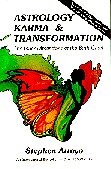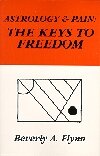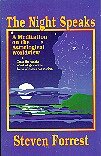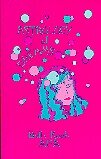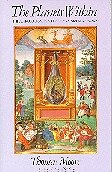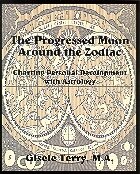July, 2011:
This is the AFA's new book, it arrived unannounced. So I opened the book at random. Later I went page by page, but wherever you land in the book, by whatever means, it reads pretty much like this. This is the beginning of chapter 8, Rotations and Revelations, the first words I read in the book:
Chaos theory states that every system in the universe moves toward greater and greater complexity and is always being stabilized by forces of chaos and order. Developmental processes mirrored through the progressed Moon reflect these very interactions of randomness and order in nature. In the symbolic world of astrology, the Moon represents the feeding of external input into the astrology chart itself, igniting internal structures of the chart with new aspects and aspect patterns that assemble and reassemble as the Moon moves in and out of orb with other planets. The internal structures and representations in the birth chart have order but they are open to new interpretations that are catalyzed by the Moon - the external information bearer. (pg. 53)
Brilliantly clear, don't you think! [M]oves towards greater and greater complexity and is always being stabilized by forces of chaos and order.
The key to this book is a simplified restatement of Dane Rudhyar's The Lunation Cycle, which Terry terms The Lunar Return Model of Development. You are confused. Is not Rudhyar talking of the Moon's 28-year progressed cycle, and is not a lunar return a 28 day cycle, and are these not both well established terms? Yes. You are correct.
So what happened to Terry? For an answer we turn to her bibliography. Which is mostly full of the texts she read to get her M.A. in Marriage & Family Therapy. She has read only a few astrologers, and only of a single school. Here is the list, and the dates of the books:
Stephen Arroyo, 1978; Bernadette Brady, 1999; Darby Costello, 1996; Greene & Sasportas, 1992; Bruno Huber, 1996; Maggie Hyde, 1992; Ray Merriman, 1991; Dane Rudhyar, 1976, 1978; Alexander Ruperti, 2005 (actually much earlier); Philip Sedgwick, 1989; Gloria Star, 2000.
Of these authors, only Brady and Merriman have written books on forecasting. The Merriman book that Terry has in her library isn't the one on solar returns, and neither of the Rudhyar books is The Lunation Cycle. When I enter books into my lists, I do not, as a rule, include any of the author's titles, and for this reason: So many people use their M.A. or Ph.D. as shields to hide their (often appalling) ignorance. To them, their degree is society's officially sanctioned proof that they are smart, that they are intelligent and therefore intellectually superior to all others. (Why do you suppose they put up with all the crap to get it?) But I am carping.
Children, for Terry, follow a rigid developmental path, which she states at various places in the book. On pg. 11, Anger, age 2; Exploration, age 3; Expansion, age 6; Reason, age 7; . . . "Greater intimacy", age 15; "Need for freedom", age 18; New responsibilities, age 21, etc. (pg. 11)
These are tied to the progressed Moon, in a cycle that starts at birth with the Moon in Aries (1-2: Emergence), then Taurus (2 - 3.5: Security), Gemini (3.5 - 5: Communication), Cancer (5-8: Attachment), pg. 35.
This is given again on pg. 14: Aries, birth to 18 months, Taurus 18 months to 4 years, Gemini years 4 to 7, Cancer years 7 to 12, etc.
And again, on pg. 99: Age 2 is anger and Mars and Aries/Taurus; age 3 is Jupiter & exploring and Taurus; age 6 is Jupiter & expansion and Gemini, etc.
Such is how the 28 year Lunar Return Model (aka Terry's revisioned Lunation Cycle, of Rudhyar) is structured. Age 28, you finish one, you start another. Age 56, you finish that, you start a third. So if you don't get it right the first time, don't worry. Mommie (see below) will return at 28, and again at 56, and you can try again. (Won't she??)
There are 19 chart examples given, all but one in biwheels, natal inside, progressed outside. None of the progressed charts are dated, which seems odd. Here is the delineation (complete) for the first:
In Chart 1 the natal Moon is in Taurus in the fourth house. This is the chart of a seven-month old girl, born into a stable home environment with loving parents and many family members who are emotionally and financially involved in her well being. Favorable alignments to other planets, including Venus in Cancer, support the interpretation of this child's need for and ability to gain the love of her family. In addition, her mother reports that her baby is very expressive, especially physically. The significance of the Taurus placement [5th house cusp, Sun and Moon - Dave] at birth suggests that a mutual communication system between mother and child that from the very onset of life promises strong physicality and emotional stability. (pgs. 56-57)
The chart in question is set for May 14, 2007, 10:32 pm, Glendale, CA. Go set it up & then scoot back here. If I had to guess, this is Terry's own daughter and if so, presumably her first. She writes with motherly pride. The physical expressiveness Terry cites is very likely from Sun & Moon both in the 5th. What Terry does not remark, probably as her skills as an astrologer are weak, is that the ascendant is 0 degrees Capricorn. If that time is correct, or the birth a few moments later, chart ruler is Saturn, debilitated in Leo in the 8th, opposed to Neptune in Aquarius in the 2nd. That's going to make the child money-hungry.
On the other hand, if the time is but one minute earlier (I checked this), Sagittarius rises. Ruler is Jupiter, back in the 12th. The child has a charmed life, but is isolated and nasty, as Sag rising brings Pluto, at 28 Sag, front and center. (Capricorn rising would blunt Pluto to some degree.) So which will it be? Greedy, or lucky? It will take a few years to find out.
So without getting fancy, this book is a one-trick pony. The stages of your life are laid out in front of you, they corresponds to the 28 year progressed Moon cycle, and even though your Moon might not be in Aries, and might not be in the first house, you will, more or less, be angry at two, lose your virginity at 15, leave home at 18, get married at 21. Not only does Gisele Terry say so, so do all the Very Important Psychologists she had to study in order to get her M.A. She cites them repeatedly and carefully footnotes each reference in the back. You can't do better than that.
You don't really need the rest of this, I am just having fun ripping the author apart, it is so delicious and easy to do.
By Dyadic in the title of chapter 3 (pg. 17), Terry opens up new worlds, but only, again, because all the Very Important People she has read have told her so. Here she is:
The important news in developmental psychology is that many processes of human development that are biologically predetermined can only be realized through relationships. (emphasis in original, pg. 17)
Development is co-created by two people. It is not a one-person process but a two-person process. (pg. 17)
The brain, which is the most unformed organ in the body at birth, requires the attunement of a relationship in order to mature. (pg. 18)
What is new and different here is that development is co-created through relationships. It is not just influenced by a relationship but is co-created at the level of brain structure and neuron circuitry. (pg. 18)
At first I read too quickly. I presumed this meant that every guy should have a girl, that if you didn't have someone in your life, that you were deprived & would forever remain stunted. That if all your relationships quickly ended in failure, if you have a week or two "in heaven", invariably followed by long lonely months, that you might just as well enditallnow. Those who chose solitary lives, well, they just don't know what they are missing and are wasting their lives, etc. That is the meaning of the word, relationship. From my own personal experience, I have learned a great deal from others. I have reconceptualized sex into something quite different, for example, and if it had anything to do with astrology, I would tell you about it.
The confusion was mine. I saw the word, dyadic in the chapter title, I presumed Terry would be dealing with dyads, which, except where stated otherwise, are relationships between peers. Have you ever been asked if you have a "permanent dyadic relationship"? No? You've never been asked if you were married?
But despite her statements, Terry limits the relationship dyad only to the child's early relationship with its mother. This is by means of the child's Moon's sign and aspects at birth, but Terry does not examine these in any great detail. A child with a Moon-Pluto aspect (that seems to be a favorite pairing), the mother will be a horror. The Moon-Uranus child forces both the child & its mother to self-internalize. A child with a Moon in Capricorn makes her mother fearful the child will reject her. - These examples from pg. 21. Another: A woman with Moon conjunct Jupiter in Pisces in the 4th house might come from a long line of caregivers, as, don't you know, this sort of thing (ability to be a caregiver, not Moon-Jupiter-Pisces-4th) is passed down through the matrilineal side of the family, from mother to daughter, to granddaughter, to great granddaughter, etc.
I was also misled by Terry's repeated use of the word, relationshipS, with an S. As in, plural. As in more than one. The mother-child relationship, the caretaker relationship, as Terry defines it, is almost never a plural affair. In Terry's world, Daddies, for example, don't count, as there is no mention of them that I could find. Only mommies, or mommy surrogates.
The unstated flaw in this theory is that children will only grow up to be as good as the mothering they had - or didn't have. That whatever you're going to get out of life was largely determined by the age of twelve or so. It cannot be changed, nor can anything of note be added, or subtracted, from it. The best that we, as forlorn, malajusted adults, might hope for is to find someone who could mother us. So that we can remain infants forever. If so, then finding a new mommie would seem to work best at ages 28-9, or 56-7, when the Lunar Return Model of Development recycles back to the start. No? Where did I go wrong, then?
In reality, there are as many examples of individuals overcoming bleak and impoverished childhoods as there are who were permanently crushed by them. I myself am an example, which is only one reason why I am displeased with such drivel. If you were hurt in childhood, as many of us were, then why, for God's sake, WHY let pseudo-intellectuals and their lying, phony theories further cripple you? Or - worse still - rationalize your manipulations?
On pg. 23, this is worked out in terms of the Moon's natal sign. If your Moon is in Aries, you need to go it alone. If in Taurus, you need security. If in Gemini, to be heard, etc. Carter, free of psychological gibberish, does far better on pgs. 109-110 of his book. Back in Terry's book, turn the page, and discover the counterbalance to your Moon, the sign opposite, which, Even if the opposite sign never appears in the chart, it is still an implied reaction. . . (pg. 24). (And again I am gobsmacked. Gisele Terry, M.A., has found charts that don't have all the signs in them. But I digress.) Here are a few counterbalances:
Moon in Aries in reaction to Libra: the need to be individualized from dependency needs and relationship with mother.
Moon in Taurus in reaction to Scorpio: the need for security as a result of crisis in mother's history or in the family lineage.
Moon in Gemini in reaction to Sagittarius: the need for communication, to be heard because of lack of focus from mother. (pg. 24)
All of this is an obvious excuse for some intense chart analysis, how specific placements in the natal chart produce specific results in terms of neural development & relationship formation, but such analysis is beyond the author's skill. (I'm not joking. This has been done.) But, hey, Terry has an M.A. I have only a lowly B.Sc., so what she says, you know, you know, it's what we gotta do.
This woman, with her excellent communication skills, actually counsels people in Los Angeles. Her book, full of the latest jargon and psych fads, will date rapidly.
AFA, 117 pages.


